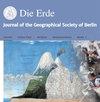2001- 2008年中国特大城市地区的多中心发展:长江三角洲与珠江三角洲的比较
IF 0.6
4区 地球科学
Q3 GEOGRAPHY
引用次数: 14
摘要
大规模城市区域正日益成为全球经济的地域支柱。这些超大城市区域中的许多都是多中心的,因为它们由一系列密集交织的城镇组成。本章的目的是分析这些多中心网络在中国两个最重要的特大城市地区的地理位置:长江三角洲(YRD)和珠江三角洲(PRD)。为此,我们采用了一种方法,通过公司总部-分支机构的联系来分析特大城市地区的空间组织变化;也就是说,我们通过观察从公司总部到公司分支机构的所有权联系,探索了特大城市地区的组成城市网络。在此过程中,本研究扩展和完善了通常用于测量多中心性的统计工具。我们的研究结果表明,在长三角和珠三角,特大城市区域之间的联系越来越多。这两个地区的共同特点是:尽管总部的集中度也在增加,但多中心性的总体水平在提高;多中心性总体水平的增长主要来源于网络密度的提高。然而,长三角和珠三角之间也存在根本性的差异:珠三角的公司更有可能在县界以外设立分支机构,这导致网络密度高于长三角;与珠三角相比,长三角的城际网络相对“平坦”,四大城市(广州、深圳、东莞和佛山)之间的公司联系较多,而其他中小城市则较少。本文章由计算机程序翻译,如有差异,请以英文原文为准。
Polycentric development in China’s mega-city regions, 2001-08: A comparison of the Yangtze and Pearl River Deltas
Large-scale urban regions are increasingly functioning as the territorial backbone of the global economy. Many of these mega-city regions are polycentric in that they consist of a range of densely interwoven cities and towns. The purpose of this chapter is to analyse the geographies of these polycentric networks in what are arguably China’s two most important mega-city regions: the Yangtze River Delta (YRD) and the Pearl River Delta (PRD). To this end, we deployed a methodology that allowed the analysis of the shifting spatial organization of mega-city regions through the lens of the headquarters–branches linkages of corporations; that is, we explored the mega-city regions’ constituent urban networks by looking at the ownership linkages running from a corporation’s headquarters to the corporation’s branches. In the process, this research extended and refined the statistical tools that are often deployed to measure polycentricity. Our results suggest that in both the YRD and the PRD there are more and more linkages interconnecting the mega-city region. The two regions share the following features: the general level of polycentricity is increasing, even though the concentration of headquarters is also increasing; and the growth of the general level of polycentricity mainly originates from higher levels of network density. There are, however, also fundamental differences between the YRD and the PRD: firms in the PRD are more likely to set up branches beyond the prefectures’ boundaries, which results in higher levels of network density than in the YRD; there is a relatively 'flatter' intercity network in the YRD compared to the PRD, in which there are more firms’ links interconnecting the four major cities (Guangzhou, Shenzhen, Dongguan and Foshan), rather than other small and medium-size cities.
求助全文
通过发布文献求助,成功后即可免费获取论文全文。
去求助
来源期刊

Erde
GEOGRAPHY, PHYSICAL-GEOSCIENCES, MULTIDISCIPLINARY
CiteScore
2.90
自引率
6.20%
发文量
0
审稿时长
>12 weeks
期刊介绍:
DIE ERDE is a publication of the Geographical Society of Berlin
DIE ERDE is a scientific journal in Geography, with four issues per year with about 100 pages each. It covers all aspects of geographical research, focusing on both earth system studies and regional contributions.
DIE ERDE invites contributions from any subfield of both Physical and Human Geography as well as from neighbouring disciplines.
 求助内容:
求助内容: 应助结果提醒方式:
应助结果提醒方式:


